For this church:    |
|
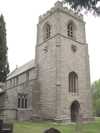 The church from The church fromthe north-west, showing the tower |
The pillars of the north arcade represent the earliest part of the present church, probably dating from the 12th Century. They are classic Norman, very simple with unadorned square capitals. However a century later the building was extended westwards by one larger bay. A feature here, as at Norwell nearby, is that a piece of wall from the earlier building, possibly part of a tower, was left in situ. The builders may well have decided not to destroy something which would assist enlargement. The lowest stage of the tower dates from this time. In the south aisle two pillars were reused but given new capitals with stylised foliage. It has been noticed that they are similar to designs at Southwell Minster, 5 miles away, which suggests that the same craftsmen were employed at Caunton.
 Detail of the tower Detail of the tower |
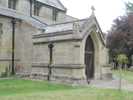 The south porch The south porch |
The chancel arch and piscina in the sanctuary date from the same period so we can surmise that the chancel itself had the present floor plan. The simple font has also been dated to the 13th Century. The tower was heightened in the 15th Century, with quatrefoil frieze, gargoyles and battlements. The south porch was added during this century.
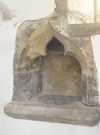 Piscina with Piscina withogee head |
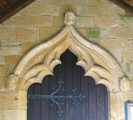 Ogee arch in Ogee arch insouth porch |
The south arcade was widened when a chantry chapel, dedicated to the Virgin Mary, was constructed under the will of Robert de Caunton (Calneton) in 1349. A piscina with ogee arch is to be seen and also a low arch which is presumed to have housed Robert’s tomb and/or his effigy, of which no trace survives. The south door was rebuilt with matching ogee arch at this time. The two priests who were to say mass and pray for the soul of Robert and his heirs were sent from Newstead Priory. Large blocks of ashlar at the base of walls in the nearby private residence, The Grange, indicate the remains of what appears to have been a substantial late medieval building which could have served as a house for the chaplains.
William Port(er) was appointed the first chaplain of the chantry in 1349 but was immediately in trouble. His trespass was to have signed the document establishing the chantry on behalf of the king – which he was not entitled to do. Presumably he was a deacon, not a priest. However, at the chapter at Southwell in 1351, on paying a fine of 6d he was pardoned and ordained priest. So the chantry was finally established. In 1385 there is mention of Robert Wynter and Richard de Aston, chaplains, who with John de Danby, clerk, received various lands previously held in Caunton by Joan, widow of William de Herthill. In 1392 Danby donated these, along with other properties in Egmanton and Starthorpe, to Newstead priory. This was probably intended to augment the endowment of Robert de Caunton’s chantry.
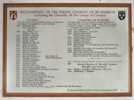 The list of priests The list of priestsin the church |
On the board near the door is a list of priests, including those for this chantry until its dissolution in 1558, when Queen Elizabeth acceded to the throne of England. The earlier narrow south aisle can be seen westwards from the south door.
There was also a chapel, dedicated to St John and the Holy Trinity, at the east end of the north aisle — now the clergy vestry and organ chamber. This chapel possibly belonged to a guild whose members would be responsible for its upkeep. To be seen are a piscina dated to the 13th Century and two carved brackets, one bearing Tudor roses and the other a head, probably not in their original places and whose purpose is now unclear. We have sparse documentary evidence about this chapel.
The first incumbent listed on the incumbents’ board is William Hull, inducted to the living in 1470. He seems to have been a troublesome character. First, in 1472 he failed to attend the Pentecost procession in Southwell and prevented his parishioners from presenting their offerings. For this he was excommunicated, a very severe punishment at that time. Secondly, a year later he was convicted of sorcery and told to resign. Apparently he stayed on, because in 1473 he was again excommunicated, for usurping the authority of the Southwell chapter in excommunicating Alice Legard. This was the last straw: he submitted and was absolved on condition that he declared his action unjust and agreed to resign.
The Reformation and its Aftermath
The upheaval caused by the Reformation on the continent following Luther’s stand against the papacy and in England following King Henry VIII’s declaration of himself as Head of the Church is well documented. In 1536 Henry’s commissioners seized the property of the smaller monasteries (those valued at less than £200). This did not cause much local unrest, as many of these were widely seen as corrupt and declining. However, in 1539 the plundering of the remaining monasteries and especially the chantries had much more local impact.
We do not know the precise events at Caunton but the name changes in close succession on the incumbents’ board suggest that the turbulence was repeated locally: presumably some were not prepared to swear the oath of allegiance to the King as Head. James Lee was incumbent in 1536, when Richard Greve of Besthorpe left a chest to the ‘church of St Andrew’, the earliest record we have of the dedication. Lee was followed by William Olyver (date unknown) and then in 1541 by William Smythe, although Lee (Leghe) was again acknowledged as vicar in 1555 in Mary’s reign, when in his will he expressed the wish to ‘be buried in the Churchyard ... before the Quere door’. Similarly the chantry list shows William Footate (1536), William Whitmoor (1537), and Richard Stanshare (or Stanshall) at the dissolution in 1539. There was a partial restoration of chantries in 1547 and Richard Stanshare was back in post. He stayed through the changes in the next decade, even becoming vicar briefly on the death of James Lee in 1555, before being replaced by Roger Jackson in 1557. But the Marian settlement was not to last; the chantries were finally dissolved in 1559. However there was compensation. Richard, now aged 59, and no longer vicar, was given a life pension of £4 per year.
He may very well have seen the destruction which went on in St Andrew’s as a result of Protestant extremists in September 1552, when the vestments, plate and bells were taken away. The chalice was ‘delivered unto the hands of the master of the king’s jewel house’, so this may have been official seizing of assets. The English monarchy was always short of money and much of the land and property which was appropriated went directly to the Exchequer or in reward to loyal supporters of the Crown. We do not know what happened to the bells, recorded as ‘ii bells in the steple, a sanctus bell & a lyttle bell in the steple’.
Caunton had a ring of three bells in the west tower from the 17th Century. These three bells have inscriptions which reveal the upheavals of the times, especially that on the last, GOD SAVE HIS CHURCH, cast in 1658 by George Oldfield of Nottingham. Earlier in the century the chancel of the church was reported as being in poor order, and Gervase Lee of Norwell who had impropriated the tithes and was thus responsible for the chancel’s upkeep, was pursued in 1636 for his failure to carry out repairs. Later there was some improvement since box pews were installed in the nave and a musicians’ gallery under the tower.
From 1708 until 1844 there was no resident priest. The living was small and was held in plurality with North Muskham during this period. This was a low period in the Church of England, when much of its pastoral work was carried out by ill-paid curates acting for the incumbent, who was often an absentee and holding livings in plurality. Small livings were provided with only the legal minimum of services — or less. We do not now know where the old parsonage house was situated, though the old school site has been suggested.
Revd Samuel Reynolds Hole
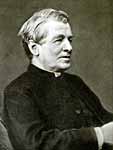 Dean Hole Dean Hole |
He was a vigorous incumbent whose busyness left us the church mostly as we see it today. Son of the squire of Caunton, he was made curate in 1844 and inducted into the living in 1850. He stayed in the parish for 37 years (43, including his curacy), until 1887, when he was made Dean of Rochester. He is always known locally as Dean Hole and was buried in Caunton churchyard in 1904.
He was nationally famous as a rose grower and judge, founder of the National Rose Show (1858) and as author of A Book of Roses (1869). His fame lives on and brings quite a few people from the USA and the Commonwealth to visit Caunton.
Reynolds Hole was at Oxford at the time of the Oxford movement and was deeply influenced by the personalities and reforms promulgated by that movement. He ensured that his parish adopted key characteristics of High Anglicanism:
 A resident priest proactive in pastoral work, as opposed to a curate, rarely
visiting parishioners and hastening from Church immediately after ‘reading’
the service.
A resident priest proactive in pastoral work, as opposed to a curate, rarely
visiting parishioners and hastening from Church immediately after ‘reading’
the service.
 The service led by a surpliced choir in the chancel, in place of a village
band in the west gallery, where they were difficult to control.
The service led by a surpliced choir in the chancel, in place of a village
band in the west gallery, where they were difficult to control.
 Holy Communion was celebrated more regularly to bring it to the heart of
worship in the parish church. Since Edward VI’s second prayer book of
1552, Holy Communion was only offered three times each year in many parishes,
Morning and Evening Prayer becoming the regular services.
Holy Communion was celebrated more regularly to bring it to the heart of
worship in the parish church. Since Edward VI’s second prayer book of
1552, Holy Communion was only offered three times each year in many parishes,
Morning and Evening Prayer becoming the regular services.
The chancel was reordered in 1869 to reflect this clear view of how worship should be performed.
Reynolds Hole was made a Canon of Lincoln in 1875. Hole was appointed Dean of Rochester in 1887, at the age of 65, and was as vigorous there as he had been throughout his years in Caunton. He undertook three lecture tours of the USA to raise money for the restoration of the ancient cathedral. He died in office in 1904, and was given a fine memorial there, while there is also a window dedicated to him in Caunton.
Restoration under Ewan Christian
Ewan Christian had been appointed architect to the Ecclesiastical Commission in 1851, and was active at neighbouring churches, including Norwell and Cromwell nearby, but especially at Southwell Minster over many years. The Ecclesiastical Commissioners were responsible for work on the chancel, but they insisted that the nave had to be restored at the same time and the vicar was responsible for raising the money to undertake this. Correspondence in the Church of England Records shows how thoroughly Hole went about this task. The printed list of contributors is to be seen on a pillar in the nave. The work done here is a good example of a Victorian restoration. All the roofs were renewed using Cumberland slate (expensive but long-lasting and then available because of the extensive rail network). The north wall of the nave was rebuilt; the windows are copies of the medieval ones; some of the old plain glass tiles appear to have been re-used, Christian surrounding them with clear glass as he did at Norwell. The floor was renewed throughout and the chancel and sanctuary raised (another High Church fashion). The pews of pitch pine were installed, with all seats free from pew rent.
 Old pulpit Old pulpitnow at Holme |
A new pulpit was made in the same material. The old one found its way into the Manor garden as a part of a summer house, but has finally returned to its original purpose. It was placed in Holme church in 1932 as part of the restoration there – well worth a visit as an example of enlightened restoration.
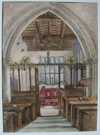 Watercolour of Watercolour ofthe chancel from 1857 |
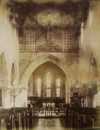 The chancel The chancelin 1869 |
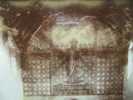 Detail of Detail ofthe 1869 painting |
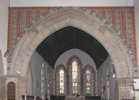 The chancel arch The chancel archtoday |
The chancel was fitted out for a robed choir, accompanied by an organ. This was placed in the north chapel, with a clergy vestry behind. The appearance of the chancel was radically altered by replacing a late 15th Century flat ceiling and straight-headed Tudor window of 5 lights. The latter is to be seen in the watercolour of the chancel made in 1857 hung on the north side of the chancel arch. The new east window consists of three lights in Early English lancet form, matching those in the north and south chancel walls dating from the 12th or 13th Century, with a new barrel roof painted in the colours and pattern considered appropriate at the time. Likewise, the wall immediately above the chancel arch on the nave side was decorated with a large painted Christ in Majesty set against a geometric pattern and the text ‘I am the Way, the Truth and the Life’. In the first half of the 20th Century, this painting was white-washed over, but after representations by the Hole family, a new geometrical design was painted with an inscription following the curve of the arch reading:
that I may go unto the altar of God’.
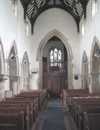 The interior looking west The interior looking westshowing tower opening |
At the west end of the nave the gallery was taken down and the ground floor of the tower was converted into a choir vestry, so that there could be decent robing and a procession to the chancel. Two memorials to Dean Hole were installed in 1905 ‘by parishioners and friends’. These are in the chancel, where oak furniture and oak wainscotting was fitted and inscribed. The window in the tower was filled with appropriate stained glass.
Recent History
Changes to the church in the 20th Century have not been so visible. The chapel at the end of the south aisle was restored in 1927 as a Lady Chapel with English altar furnishings. This was paid for by members of the Bristowe family, long resident in the parish. Over three centuries they had placed memorial tablets on the walls, graves in the floor and stained glass in the windows of this part of the church, all displaying their arms, sometimes also accompanied by those of families into which they had married, so that for many years it was known as the Bristowe chapel.
In 1936 the three 17th Century bells were installed in a new cast iron frame, with fittings for chiming not ringing. This is explained by the fact that the tower has shown a tendency to lean to the west (obvious to the eye, and confirmed by cracks in the stonework and leaning north and south aisle pillars), so there would have been concern about additional stresses caused by full-circle ringing. However, in 1992 the PCC commissioned a survey which showed that no further settlement had taken place. These bells were restored to full-circle ringing and an enthusiastic group of bellringers was able to raise sufficient funds to fit a new frame and three additional bells (1629, 1896 and 2003).
Hanging near the font is a roll of honour listing “all ranks who served from the parish of St Andrew 1914-1918”. It is handwritten on the official form by the vicar, Revd John Tinkler, and he has added details of those who lost their lives. The names of the seven fallen are to be found on the bronze memorial. In 1995, 50 years after the ending of World War II, a list of those serving in the armed forces was made. There were no casualties amongst these, but the loss of a resident villager in an air raid on a Newark factory is recorded.
In common with other rural parishes, the benefice of Caunton ceased to form a single living in the late 20th Century; between 1976 and 1990 it was linked with those of North Muskham and South Muskham, but from 1990 it has formed part of the joint-benefice of Norwell, Caunton, Cromwell and Ossington. Currently this benefice is held by a priest-in-charge also responsible for another joint benefice, that of Sutton-on-Trent, Normanton, Carlton-on-Trent and Marnham.
The Community
The gentry of Caunton have lived at the Manor, Beesthorpe Hall and Earlshaw since the Middle Ages. In recent centuries, the most influential have been the Holes, who came to Caunton in the sixteenth century, living later in The Grange (possibly the residence of former chantry priests) from 1760 and subsequently also in the Manor. Their fortunes rose with the substantial brewing industry centred on Newark after transport improvements made more extensive trade possible. (The Great North Road was usable throughout the year after 1760, the Trent was made navigable through Newark in 1774 and the railways came in 1846.) Monuments in the chancel record some members of this family, including several who had resided elsewhere.
Methodism was strong in Nottinghamshire from its foundation. Two 19th Century chapel buildings survive, both now converted into private houses. Several members of the Antcliffe family were enthusiastic Primitive Methodists. They had come to Caunton in 1816 and started with a small chapel, probably in a cottage. Much to the annoyance of the Vicar, Reynolds Hole — who called them Ranters and noted any scandalous behaviour — they were strong enough in 1861 to build a chapel of their own in Ford Lane adjoining an existing cottage. The second surviving chapel was built by the Wesleyan Methodists in 1892 on Mill Lane/Norwell Road. They did have earlier buildings, but the date of the earliest Wesleyan fellowship is not known.
The Church school was founded in 1840, shortly after the Act of Parliament which allowed public money to be spent for teaching poor children. It was built on church land, taken from Glebe Farm (but possibly the site of the original vicarage), with support from the Holes and the Bristowes. During his incumbency, Reynolds Hole was a regular visitor and he recruited his choir from the schoolboys. The building survives, but it ceased to be the school in 1971, when the number of children led to a new building being required. It was converted into a private house in 1984, having spent the intervening years as a farm building, appropriately part of Glebe Farm again.






